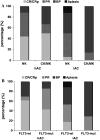Efficacy and feasibility of cyclophosphamide combined with intermediate- dose or high-dose cytarabine for relapsed and refractory acute myeloid leukemia (AML)
- PMID: 24728467
- PMCID: PMC11823505
- DOI: 10.1007/s00432-014-1666-7
Efficacy and feasibility of cyclophosphamide combined with intermediate- dose or high-dose cytarabine for relapsed and refractory acute myeloid leukemia (AML)
Abstract
Background: Approximately, 70 % of adult patients with de novo acute myeloid leukemia (AML) achieve a complete remission (CR) while 10-20 % of AML are refractory to induction chemotherapy. Furthermore, a significant proportion of AML patients in CR will relapse during or after consolidation treatment. There is no evidence for a standard salvage regimen and most centers use a combination of an anthracycline and cytarabine (AraC). The aim of this study was to investigate the impact of two age-adjusted regimens containing AraC and cyclophosphamide applied for the treatment of relapsed or refractory AML.
Patients and methods: We retrospectively analyzed 60 patients (24 male, 36 female; median age 56 years) with relapsed or refractory AML who were treated with a combination of AraC and cyclophosphamide monocentrically between October 2000 and January 2013. Two different protocols containing either high-dose (hAC) or intermediate-dose cytarabin (iAC) have been applied dependent on age and performance status.
Results: We demonstrate an overall response rate (CR + PR) induced by hAC and iAC of 56.7 %. Importantly, a complete remission rate (CR + CRp) of 52.2 % was found in patients who received the hAC regimen while only 8.8 % of patients achieved a CR following the iAC protocol (p < 0.001). The rate of refractory disease was 26.1 and 47.1 %, respectively. High-risk cytogenetics, i.e., a complex aberrant or monosomal karyotype had no effect on achievement of CR after hAC. In addition, there was no impact of activating FLT3 mutations on response to treatment according to the hAC regimen. In the cohort of patients treated with the iAC protocol, treatment-related mortality of 11.8 % within 60 days was observed but none of the patients who received the hAC regimen died within the first 2 months following chemotherapy. The toxicity profile was acceptable at both cytarabine dose levels. Importantly, 19 patients (82.6 %) of the hAC cohort underwent allogeneic hematopoietic stem cell transplantation (HSCT) as consecutive treatment.
Conclusion: The hAC regimen represents a promising therapeutic approach to induce a second CR in younger patients with relapsed or refractory AML prior to HSCT without using anthracyclines.
Conflict of interest statement
None.
Figures

References
-
- Breems DA, Van Putten WL, Huijgens PC et al (2005) Prognostic index for adult patients with acute myeloid leukemia in first relapse. J Clin Oncol 23:1969–1978 - PubMed
-
- Breems DA, Van Putten WL, De Greef GE et al (2008) Monosomal karyotype in acute myeloid leukemia: a better indicator of poor prognosis than a complex karyotype. J Clin Oncol 26:4791–4797 - PubMed
-
- Brothman AR, Persons DL, Shaffer LG (2009) Nomenclature evolution: changes in the ISCN from the 2005 to the 2009 edition. Cytogenet Genome Res 127:1–4 - PubMed
-
- Büchner T, Schlenk RF, Schaich M et al (2012) Acute myeloid leukemia (AML): different treatment strategies versus a common standard arm–combined prospective analysis by the German AML intergroup. J Clin Oncol 30:3604–3610 - PubMed
-
- Chevallier P, Labopin M, Turlure P et al (2011) A new leukemia prognostic scoring system for refractory/relapsed adult acute myelogeneous leukaemia patients: a GOELAMS study. Leukemia 25:939–944 - PubMed
Publication types
MeSH terms
Substances
LinkOut - more resources
Full Text Sources
Other Literature Sources
Research Materials
Miscellaneous

